Remaking Boracay
As the motorized tricycle loudly puttered down the two-lane road hugging the northwestern coast of Panay, the Philippines’ sixth-largest island, I could clearly see the effects of Typhoon Rosita (Yutu) as it approached the shores of Luzon some 530 kilometers (or 330 miles) to the north. The agitated waters of the Sibuyan Sea seemed to dance feverishly beneath brooding gunmetal-gray skies; it didn’t bode well for the boat ride I was about to take across the narrow strait to tiny Boracay.
It was October 29, 2018, just three days after Boracay had formally reopened to tourists on the heels of a controversial six-month shutdown, and I had come to report on the drastic changes that had taken place on this island of just 1,032 hectares (2,550 acres). I was curious to see how authorities were rebooting the Philippines’ most celebrated beach destination. Pint-sized Boracay had welcomed an astounding two million tourists in 2017, largely drawn by the postcard-perfect stretch of bone-white sand running four kilometers along its western coastline, aptly named White Beach. Others came for watersports like stand-up paddleboarding and kitesurfing run out of the small, budget-friendly hotels fronting the reef-protected bay at Bulabog, a short walk from White Beach across a heavily built-up neck of land. Then there were the parties. Fire-dancers and superstar DJs like Steve Aoki set the scene for celebrations like the annual LaBoracay festival over the Labor Day weekend. Boracay was even crowned with the title “Best Island in the World” by big-name international magazines like Condé Nast Traveler.
But its meteoric rise masked an underlying problem that was getting harder and harder to ignore. By the time a cousin went six or seven years ago, Boracay had become a poster child for overtourism. His assessment? “White Beach was beautiful, but when I went snorkeling there was nothing to see – all the corals were dead.” Indeed, a Japanese-led environmental study found that the island had lost a whopping 70 percent of its reefs between 1988 and 2011, partially because corals were being trampled by hordes of careless snorkelers. Just as alarming was the fact that its waters had been tainted by raw sewage. High concentrations of coliform bacteria (exceeding safe levels by as much as 47 times) were detected in Bulabog Bay, while algal blooms appeared with increasing regularity, discoloring the azure-blue water and washing up on White Beach in sickly green patches. Boracay was now a cautionary tale for the rest of Southeast Asia – a picture of how rampant, uncontrolled development could subsume a once-tranquil backpackers’ haven beneath a tide of mass tourism.
Of course, that was all before the aforementioned shutdown on the orders of Philippine president Rodrigo Duterte, who infamously branded the whole island a “cesspool” last February. The jewel in the country’s tourism crown no longer accepted visitors as thousands of Filipinos suddenly found themselves without work, deprived of their livelihoods for the next six months. The government introduced strict regulations in an attempt to reverse years of environmental damage and set things right. Not only would every hotel need to be hooked up to the expanded sewerage system; those on the beachfront now had to install their own small-scale water treatment plants or team up with neighboring properties to build a shared one. And any beachside structure found to be within 30 meters of the high-tide mark would be torn down. Hotels that did not comply with the new rules simply wouldn’t be granted permission to reopen.
The rules would also affect visitors, with no tourist allowed to set foot on the island without an advance booking at a government-approved hotel. And so it was with a tinge of trepidation that I arrived at Caticlan Jetty Port, where constantly shifting lines led to an ad-hoc tourist verification counter in the car park. Representatives of the provincial government were on hand to scrutinize a printout of my hotel booking and check it against a list of approved lodgings. Inexplicably, the verification form required far more detail than the immigration card I’d filled in before touching down in Manila just that morning. A purple stamp on the back of my hand signaled that I could move onto the next stage. Then it was time to pay for the actual ferry ticket, a separate “terminal fee” at the next counter, followed by an environmental charge, all on different scraps of paper. I still had to put my bags through an x-ray machine and write down my personal details on an additional white sheet. This was collected by an officer before I finally boarded the boat via a rickety gangplank.
By the time I’d crossed the channel, flagged down a tricycle for the final leg, and checked in to a cheap hotel on Station 3 – roughly one-third the way up White Beach – I was exhausted. Not so much by the convoluted pre-boarding process that had confronted me at the ferry terminal, but the accumulative effects of what was an already long journey. Getting here had involved a four-hour red-eye flight from Jakarta, followed by a six-hour layover in Manila before the short hop to Caticlan, whose small airport was easily the closest to Boracay. After tucking into Filipino fast food and stocking up on bottled water at an eatery just a few doors down from the hotel, I took a much-needed shower and collapsed into bed.
The next day brought a lunch appointment with the general manager at Discovery Shores Boracay, a five-star resort at Station 1 on the quieter northern end of White Beach. Not wanting to show up soaked in sweat, I hopped onto the back of a motorbike piloted by 26-year-old Kevin Obiso. The shutdown had cost him his job as a waiter at a Boracay mall, and since returning from a stint as a street food vendor in Manila, Kevin’s meager income now came from his informal work as a habal-habal (motorcycle taxi) driver. “If the restaurant doesn’t reopen, I will apply to be a waiter at another place,” he told me, as we wove through the single-file traffic down a dusty, half-finished road. Eventually I bid goodbye to Kevin outside Discovery Shores and wished him luck. Once inside the resort’s newly opened Italian restaurant, I was quickly introduced to Anthony Raymond, a Manila-based chef who regularly visits Boracay to help supervise Discovery Shores’ kitchens. “I’m jealous that this is your first time here,” he said cheerfully. “And seeing how pristine the water is – how there aren’t any boats and how quiet it is with no jet skis.”
Longtime residents and veterans of the local tourism industry exclaim that White Beach – since cleared of umbrellas, sun loungers, even the large sandcastles that were popular photo ops – now looked as it did 20 years ago. The dramatic improvement in the water quality was beyond all doubt. Local municipal lawmakers, led by a prominent watersports athlete turned environmentalist, recently passed a regulation banning single-use plastics throughout the island. And the government no longer allows smoking, drinking, and open fires on the beach, while big parties and casinos have also been banned in an effort to transform the island into a more family-friendly destination. “There was a lot of political will behind this,” Anthony added. “It’s a lesson for the other [Philippine] islands on what can be done in a short time.”
Soon the jovial general manager, Erwin Lopez, walked in. He was a casually dressed, youthful-looking Manileño who appeared to be about my age, if not a few years older. Over plates of squid-ink spaghetti and salad dressed in a dollop of homemade ricotta, he made the case that Boracay never lost its easygoing vibe despite the rampant development over the past decade. Understandably, Erwin wasn’t too pleased with some of the new rules, particularly the ban on portable furniture at White Beach. “They also have to think about guest comfort. How can we offer a world-class experience – and I mean the beach in general – if we tell them to lie on a towel on the sand and roast in the sun? Beach beds and sun loungers are something we must have.”
I then got a taste of the Philippines’ fabled culture of hospitality. When Erwin found out I was a big fan of Filipino food, he asked the waitstaff to bring in generously portioned local specialties from another of the resort’s restaurants: crispy pata (deep-fried pig trotters served with two or three dips) and Bacolod kansi, a sour young jackfruit stew. The crispy pata, for the record, was utterly divine. Our lunch came to a sweet finish with an enormous scoop of homemade ice cream in a classic Filipino flavor that happens to be my favorite, not only because of its striking violet hue but also its rich earthiness. This was none other than ube, or the humble purple yam.
Those of you who have followed my blog for some time know that I am an inveterate foodie, and though Boracay’s beaches were extraordinarily beautiful, nothing could shake my abiding interest in Filipino cuisine. After going on an extended tour of the resort and a languid stroll around the headland to neighboring Diniwid Beach, Erwin and I parted ways as evening begins to fall. Acting on his recommendation, I took the short walk from my hotel to Subo Boracay, where patrons dine alfresco in a breezy courtyard or a stilted wooden pavilion with a no-shoes policy. Both were undeniably atmospheric, but I preferred the latter for its capiz-shell windows and timber fretwork, not to mention how it felt like stepping into the ancestral home of a local friend. The dining room was festooned with antique lamps hung from the rafters, a tall tribal woodcarving in one corner, bulky vintage clothing irons placed beside slender wooden pillars, and an arrangement of decorated old spoons framed on one wall. I immediately noticed that all female waitstaff wore a billowy embroidered scarf in a nod to the Spanish colonial-era pañuelo.
Over the next two days, Subo became my go-to spot for meals between interviews and explorations of the island. My first choice was a hotplate of sizzling sisig (chopped pork jowls and ears) with two fresh eggs cracked over the top, offset by a tangy young mango salad dressed in shrimp paste on a bed of diced red onions and tomatoes. I also tried the garlicky squid-ink fried rice humay negra and grouper kinilaw, or Filipino-style ceviche, on two separate occasions. At one point, a quiet lunch service allowed me to strike up a conversation with a server named Rosalie, who had managed to retain her job even when tourism dried up for six months. But business was quickly on the rebound. “Last night we were so busy,” she said with a smile. “We had Chinese, Koreans, people from Manila… every table was full. Tomorrow we’ll have live music and traditional dance performances at seven. You should come!” Other venues across the island were also in a festive mood: I heard Silent Night being played over the sound system at one beachside restaurant even though it was only the end of October. For those on Boracay whose livelihoods are wholly dependent on tourism, the island’s reopening must have felt like a much-awaited Christmas gift. ◊





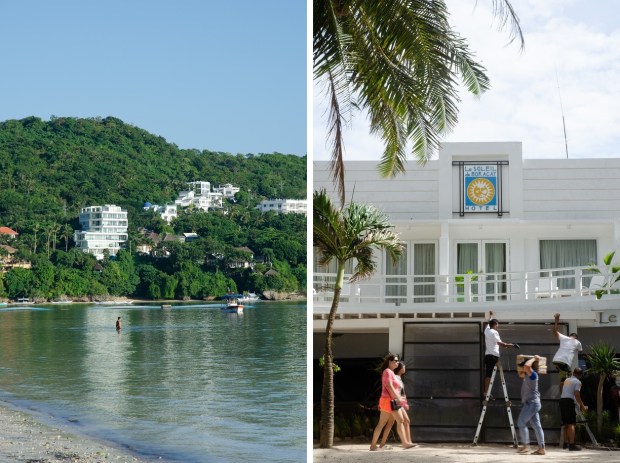

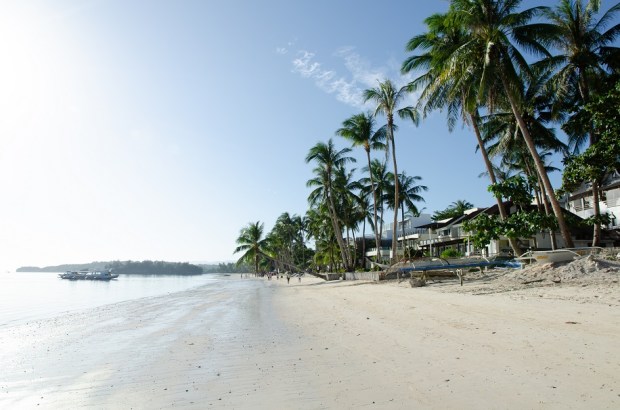

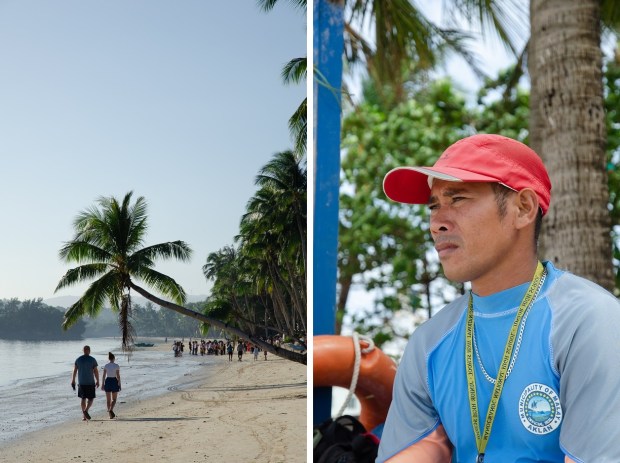


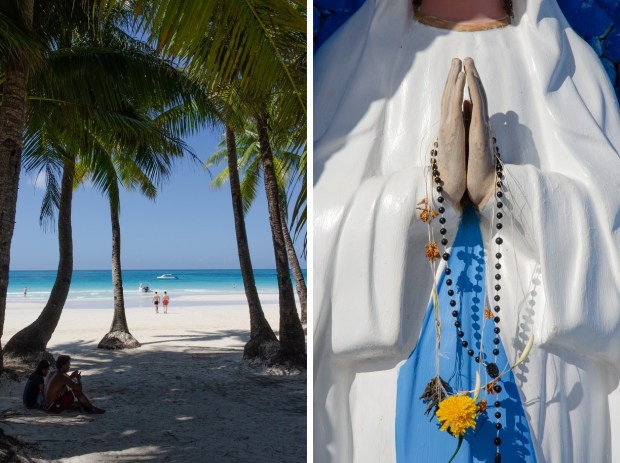


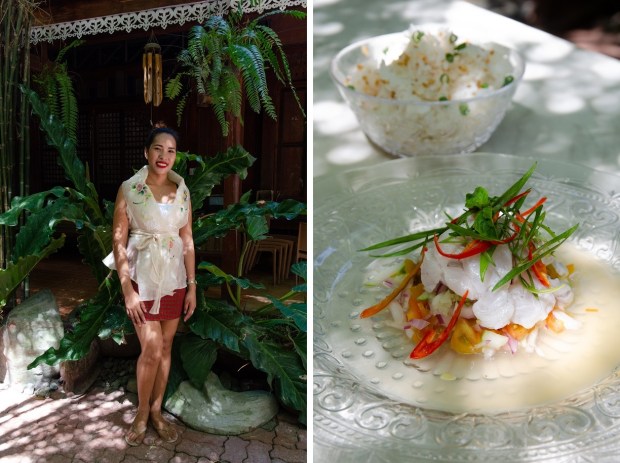
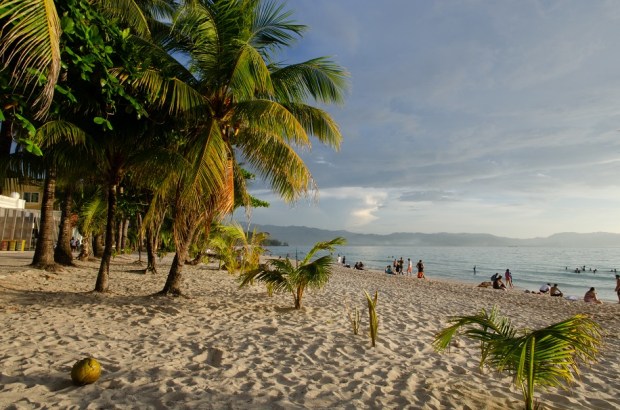


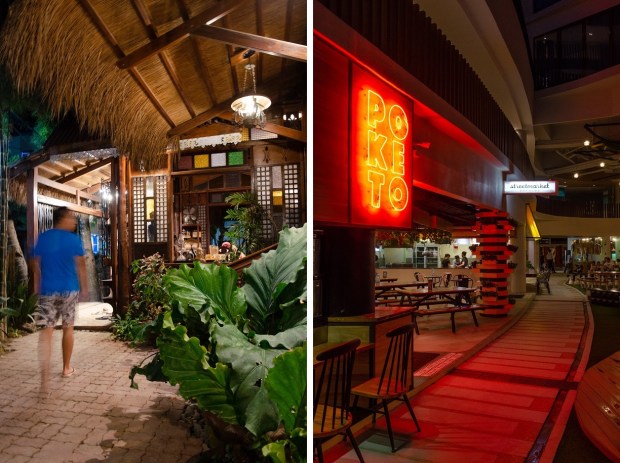




Rampant, irresponsible development has ruined so many places in Southeast Asia. It is good to see that Boracay is getting cleaned up, but such an abrupt closure had to be hard on the locals. The problem is that these illegal and unsustainable developments should never happen in the first place. Thailand, Indonesia, Philipines, etc, need to enforce these standards in advance so the places don’t get spoiled. And travelers must take better are of places, making sure not to litter and destroy coral.
The general trend for much of Southeast Asia is very concerning. Lessons aren’t being learned from Boracay on so many fronts; the issue is low environmental awareness combined with endemic corruption, which means local officials are willing to look the other way to accommodate greedy developers. Southern Cambodia is a textbook example of this – Sihanoukville was recently removed from online travel guides like Travelfish because it has been completely destroyed by mass casino-based tourism over the past decade. Here in Indonesia, the government still remains fixated on tourist arrival numbers despite the fact that Bali is bursting at the seams and running out of water (their proposal to create “10 New Balis” elsewhere isn’t terribly inventive or effective).
I visited Boracay 1 year before the cleanup. Maybe it’s time to visit again to see how much it has improved.
You’ll see a major difference for sure – practically everyone I spoke to there said how much nicer the beaches are now.
Great post 🙂
Thanks for reading. 🙂
Interesting post James. I avoided Boracay on a visit to the Philippines in 2015 as the crowds scared me off. I feel for the locals who lost their jobs during the shutdown, but it sounds like drastic action was/is needed and I applaud the efforts (though the ban on beach furniture seems a bit odd). I’d very much like to see the new Boracay.
I chuckled when I read about Silent Night. My mother is in a seniors’ facility staffed mostly by wonderful Filipinos. In the throws of Christmas activities they told me that in the Philippines they start with festive music and decorations as early as September/October. Call me a grinch, but I’m not sure I could handle three months of Christmas music!
Caroline, I’m not surprised you didn’t go while in the Philippines. The head of a tour company I interviewed told me he was part of a group lobbying the government for years about the worsening environmental degradation on the island… unfortunately no one important seemed to care until things got really bad. He wasn’t against the closure per se, but said the right approach would have been to carry it out in phases. The cleanup would have taken longer, of course, though local workers would have been less adversely affected that way.
Christmas decorations were already up at the airport in Manila when I stopped over there. As much I enjoy and love the festive season, think I too would go crazy if people started playing carols so early in the year!
What a fantastic post, James. Thanks for such an informative follow-up after Boracay’s regeneration. I never went there for the very reasons it was shut down. Through your photos it’s easy to see the why the location has been so over-touristed (that beach!) and how much more enjoyable it can be with this new approach. More and more places around the world will surely follow suit in restricting and controlling tourism (Bhutan being an early example) as more people are able to afford to travel. It’s unfortunate that locals bear the hardship during transitions such as this one, but the lessons learned by all of us will hopefully make us better travelers, as well as keepers of the places we love. Happy holidays! ~Kelly
Putting limits on tourism numbers really seems to be the best way forward – especially now that so many destinations are grappling with the effects of Instagram-driven travel and the profusion of low-cost carriers. It was really quite strange to go to Boracay just a few weeks after visiting Bhutan. I keep wishing that government officials and industry leaders here in Indonesia had the wisdom and foresight of their Bhutanese counterparts. Thanks so much for the thoughtful words, Kelly, and happy holidays to you too!
Boracay and Maya Bay fell victim to their own beauty, thanks to uncontrolled mass tourism. At least, authorities in the Philippines and Thailand finally realized the huge environmental problems both places faced. I can’t help but think of some beaches in Indonesia that seem to be heading down the same path both Boracay and Maya Bay took in the past — the government appears to be capitalizing on the country’s beaches with not enough measures to keep the ecological balance in check.
Anyway, with regards to Boracay, you know how high my standard for beach is — I blame those pristine, white sand beaches in eastern Indonesia. However, I am really impressed by your photos of the beaches on this Philippine island. They look so wide and impeccably clean, although we all know this was not the case until its temporary closure last year. And the food! It all looks and sounds amazing! If only there was a decent Filipino restaurant here in Jakarta.
Filipino food is seriously underrated. Those meals were the highlight of my time in Boracay and I enjoyed them even more than the regular walks up White Beach. Bama, I know what you mean about having high standards when it comes to beaches – especially after our trips to Flores/Komodo and then Maluku. I’m hoping that as the new tourism minister who isn’t an unimaginative bureaucrat, Wishnutama will settle on a more sustainable, forward-thinking approach to develop the industry. The numbers-oriented approach and deeply flawed “10 New Balis” initiative both need to go.
The story of Boracay fills me with both despair and hope. Tourism, of which I have been an enthusiastic yet unsettling part, has so much power to do good and do bad. Like others who have commented, I lament the layoffs of so many people on such short notice, but I’m heartened that the commitment to clean this place up was serious and, apparently, successful so far. I agree that limiting visitor numbers must happen in many places, and I am thrilled to see that small parts of Asia are banning single-use plastics these days. Meanwhile, here I am rushing off to Angkor Wat early next year because I fear it will soon be on a shut-down list. I feel selfish about that choice at the same time that I know I am largely a responsible traveler. Ugh – so much angst in wanting to see the world!
I hear Bali has also recently banned single-use plastics, though I don’t know if this new rule is strictly enforced. As popular as Angkor Wat may be, it’s hard to imagine Cambodia ever shutting it down for any period of time – it is their top draw after all! The funny thing is that I have still not been there, despite living in Southeast Asia the past 3.5 years, and also in spite of the fact that I’m a huge fan of ancient ruins. I saw from your comments on Alison’s latest posts that you’ll have a day-long layover in Hong Kong on the way back. If you need any help or advice ahead of the trip, feel free to drop me a line!
I had already planned to ask you about Hong Kong! (Just getting distracted by holiday stuff …) I think I have your email; will write for sure!
You can send a message to contact@notesplusultra.com; I’ve just set up email forwarding so it will go straight to my personal inbox!
Boracay is a lesson for the world — not just Asia
Indeed. My hope is that more places around Southeast Asia learn from Boracay’s mistakes and find ways to develop in a careful, sustainable manner.
What a beautiful place. How wonderful that it has been/is being restored to its former glory. I’m so glad something was done to turn it around. It really does sound as if it was a cesspool. And now, as seen in your gorgeous photographs, it looks absolutely heavenly. The Philippines have been on the list for quite a while now, and I think Boracay just went to the top.
Alison
The island’s transformation in such a short period of time is truly astonishing – I reckon no one had anticipated just how successful the cleanup was going to be. Nature can recover so quickly if we give it the chance to do so. Fingers crossed the beaches and sunsets will be just as beautiful when you and Don eventually visit!
Sounds like the story of most beautiful destinations in south Asia. Apathy and corruption are much to blame. Expecting a Bhutan level of environmental awareness is too much to ask I guess. Creditable that effort was taken to reverse much of the damage. Hope more countries follow suit. India certainly needs to. Thanks for the excellent account and photos James.
My pleasure, Madhu. Here in Indonesia the problems are very similar – endemic corruption means government officials are willing to turn a blind eye to over-development for short-term financial gains. And it doesn’t help that environmental awareness among the local population is astonishingly low: both city-dwellers and rural residents treat rivers and roadsides as de facto garbage dumps. I can only hope things change before the more popular destinations are ruined forever.